Labels - Urgent.
- Home, index, site details
- Australia 1901-1988
- New South Wales
- Overview of NSW
- Telegraph lines
- Telegraph Offices
- Date stamps
- Forms
- Envelopes
- Rates
- Stamps
- Queensland
- Overview of Qld
- Telegraph lines
- Telegraph offices
- Date stamps
- Forms
- Envelopes
- Rates
- Stamps
- South Australia
- Overview of SA
- Telegraph lines
- Telegraph Offices
- Date stamps
- Forms
- Envelopes
- Rates
- Stamps
- Tasmania
- Overview of Tasmania
- General developments
- Reports
- Organisation
- Telegraph lines
- Telegraph Offices
- Date stamps
- Railway lines
- Forms
- Envelopes
- Rates
- Stamps
- Overview of Tasmania
- Victoria
- Overview of Vic.
- Telegraph lines
- Telegraph offices
- Date stamps
- Forms
- Envelopes
- Rates
- Stamps
- Ephemera
- Western Australia
- Overview of WA
- Telegraph lines
- Telegraph Offices
- Date stamps
- Forms
- Envelopes
- Rates
- Stamps
Urgent labels were used at three distinct periods for Australian telegrams:
- from about World War 1 through to the 1920s - when there was an insufficient supply of paper for the Urgent rate delivery forms;
- in the World War 2 period when there was an insufficient supply of paper due to War economies;
- after 1974 when Urgent rate forms were abolished due to insufficient use.
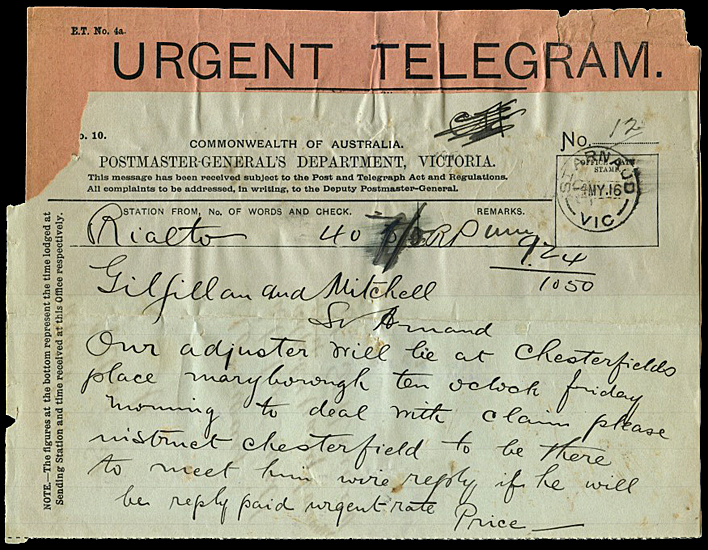 Provenance: Dave Elsmore. |
VI-LU-1.
Used on a Reply-Paid form sent from Rialto to St Arnaud Characteristics of label:
|
| No image presently available. | AB-LU-1.
Characteristics
|
| No image presently available. | AB-LU-2.
Characteristics
|
 Label used on AB-GS-36. |
AB-LU-3.
Cairns to Melbourne C.T.O. Characteristics
|
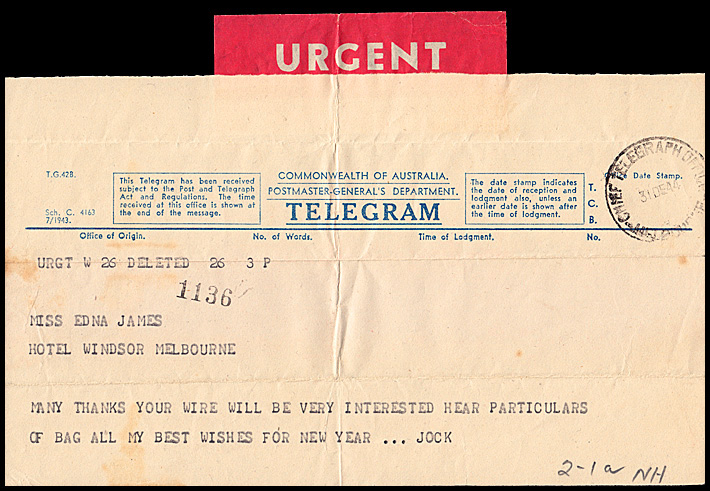 Label used on AW-DO-10B (43). See also example used at Townsville. |
AW-LU-4.
Telegram to Melbourne Characteristics of label:
Used between 31 December 1944 and February 1954. |
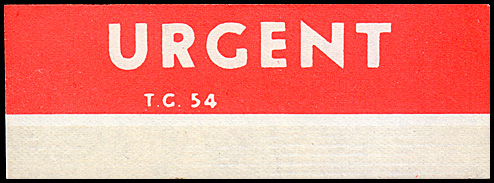 |
AW-LU-4 - unused example. |
.jpg) Provenance: Dave Elsmore. |
AW-LU-5.
Unused example. Characteristics of label:
|
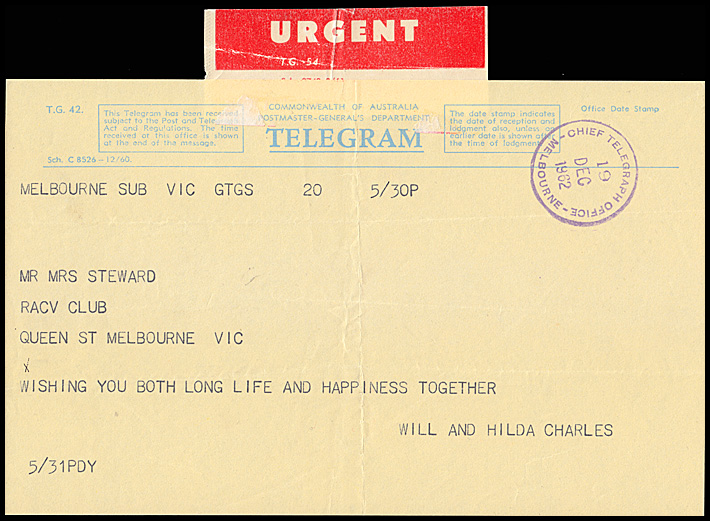 Label used on AA-DO-10(60). |
AA-LU-6.
Melbourne for local delivery Characteristics:
|
 Schedule number Sch. 3435/66 (printed in 1966). |
AA-LU-7.
Used on generic greetings envelope (AA-GGE-2a) but no date stamp to show when it was used. Characteristics of label:
|
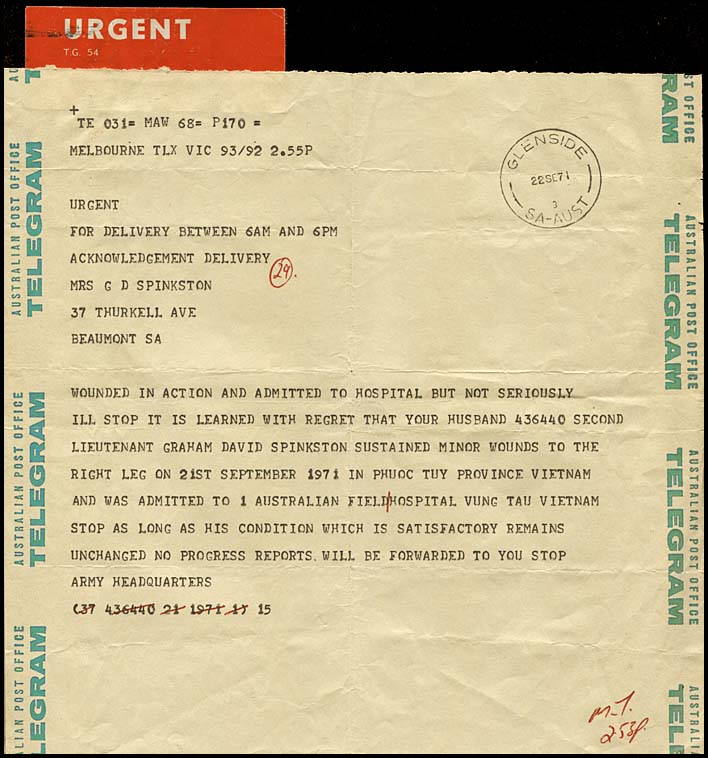 Urgent label O/N C 3566/67. Provenance: Anne Fricker. |
AA-LU-7.
Used on delivery form AA-DO-13D at Glenside, South Australia on 22 September 1971. Telegram notifies family of a casualty in the Vietnam War. |
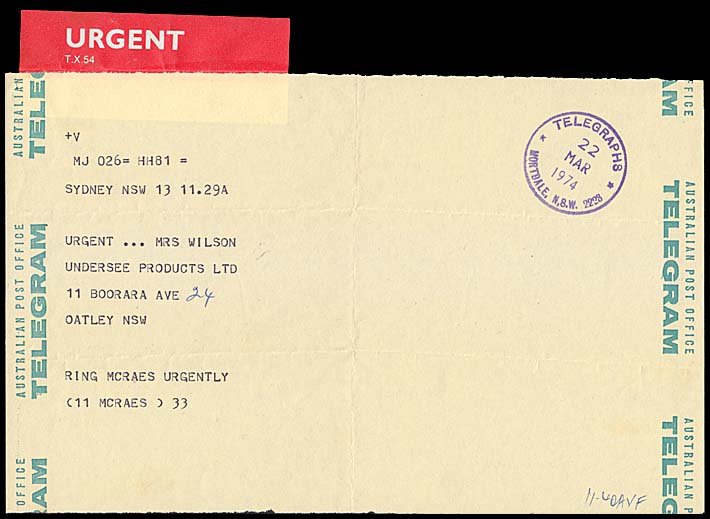 Used on a AA-DO-13D form. Used on a AA-DO-13D form. |
AA-LU-8.
Sydney to Label number changed to |
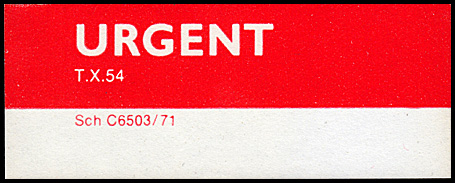 Printed in 1971. |
AA-LU-8.
Unused label. Characteristics:
|
.jpg) Use of the LU-8 URGENT label (1975 printing) on a Phonogram with an Overseas label (1978 printing) as well. |
|
 Printed in 1976. |
AT-LU-9.
Unused label. Characteristics:
|
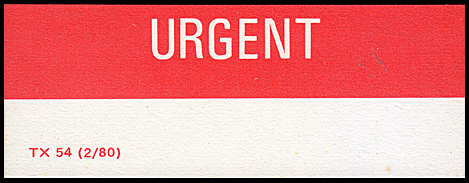 Printed in February 1980. |
AT-LU-10.
Unused label. Characteristics:
|
 Printed in February 1980. |
AT-LU-11.
Unused label. Characteristics:
|
Details of use and rarity.
| Form sub-number | Schedule number | Earliest recorded date | Rarity |
| VI-LU-1 | None. | 4 May 1916. |
RRRR |
| LU-1 | Sch. C. 107 - 6/1927. | (H p. 230) | RRR |
| LU-2 | None. | (H p. 231) | RRR |
| LU-3 | None. | 17 June 1939 at C.T.O. Melbourne. | RR |
| LU-4 | None. | 31 December 1944 at C.T.O. Melbourne. | R |
| LU-5 | Sch C. 6815/52 |
RR | |
| LU-6 | Sch 3743 6/61 | 19 December 1962 at C.T.O. Melbourne. | R |
| Sch. C. 8997 - 9/62 | |||
| LU-7 | O/N. C.3252.-6/65. | 15 January 1970 at Blackall, Qld | R |
| O/N. C.3435/66 | R | ||
| O/N. C.3566/67 .... | 22 September 1971 at Glenside, S.A. |
R | |
Sch. C5433/68 |
30 July 1978 at C.T.O. Hobart. |
R | |
| LU-8 | Sch C6503/71 | 9 February 1976 at CTO Hobart |
RR |
| Sch C 6973/72 | 22 March 1974 at Telegraphs, Mortdale, NSW. | RR | |
Sch. C7391/73 |
24 December 1974 on a Phonogram used at Hobart. |
RR | |
| Sch CT 8341/75 | 3 March 1982 on a Phonogram used at Hobart. |
R | |
| LU-9 | Sch. C8602/76 | ||
| LU-10 | None but has (2/80) after form number. | ||
| LU-11 | None but has (2/80) after form number |